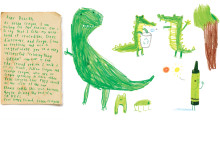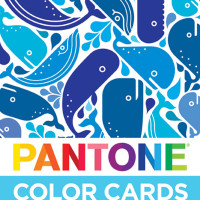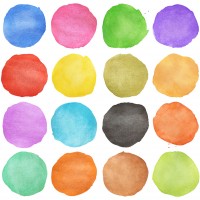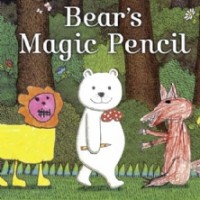Duncan is the same as every other boy – he’s a keen little artist with a box full of colourful crayons. So what a surprise when he opens the box one day to discover a bevy of little letters where his crayons should be. It appears the crayons have quit!
Why on earth is this protestation taking place? Up first is Red Crayon. Written in his trademark shade, he tells of his demanding role supplying colour for apples and fire engines, even working holidays to ensure Santa and Valentine’s Day hearts are perfect. In short, he clamours, “I need a rest”
Then there is Purple Crayon. He is the chosen hue for grapes, dragons, wizards, and has no objection to such usage. However, from now on, he would like to be kept within the lines please! And threatens to “completely lose it” if this condition is not met. (A touch OCD, methinks!)
And so it goes on: Beige Crayon is frustrated at being selected for nothing other than drawing single stalks of wheat… White Crayon feels like he doesn’t feature at all – he gets used a lot, but why bother when it is the same colour as the piece of paper he is being used on (he writes his note on a black sheet of paper, to drive the point home)…Yellow Crayon points out he should be the sun and that Duncan will need to explain this to Orange… Orange Crayon: “I see Yellow Crayon already talked to you, the big whiner” and then explains he is obviously the choice for the sun, as he was used by Duncan twice for this very purpose to Yellow’s once. He even throws in the humour card: “Orange ya glad I’m here!”
The crayons in this book are not only funny and individual in their complaints, they also offer a pertinent parallel for children, expressing their feelings to a range of complex social situations children might encounter, whether it’s being pigeonholed or caught between feuding friends
Grey Crayon is the one being pigeonholed, always chosen to colour in big elephants, whales and hippos, while Green Crayon is caught between feuding friends. He writes to say thanks for all the great colouring jobs he gets to do, but could Duncan please help yellow and orange as they are no longer talking and it is getting very very difficult. It touches on gender issues: Pink explains “I don’t get used as much as I used to… It’s because you think I’m a girls’ colour, isnt it?”, and even on modesty when Peach complains that the wrapping has come off so she’s too embarrassed to come out of the box.
After reading the litany of complaints, Duncan sets to work to rectify the situation with one glorious picture that sweeps away the stereotypes haunting his colourful friends. There is a sea of green with a pink dinosaur, an orange whale, blue wizard, grey penguins, a white seal and an array of green hearts.
This is author Drew Daywalt’s first children’s book – he is better known as a writer and director of horror films. And indeed, his finely tuned ability to hone in on the drama that unfolds from even the most mild mannered of encounters is perfectly demonstrated in this tattle of a tale. As Daywalt himself explains, upon sitting down to brainstorm some ideas for a children’s books, he simply spied a sorry looking box of crayons, began a mental conversation with them, and the rest, as they say, is history.
As for the illustrations, Jeffers’ well-known stick man styling is the ideal match to this quirky little story of crimes against crayons, however, one little mystery that has cropped up in our reading of the book is that Jeffers credits “a few little friends” at the back of the book. So do these childlike drawings owe their pedigree to children themselves, or were the aforementioned little friends purely inspiration?
No matter, the illustrations are a fabulous motivation for kids and parents alike to get stuck in, pull out their own crayon box and start making colourful anti-stereotypes to rival Picasso’s Blue Period (avoiding Blue, of course. His complaint was that he’s a bit stubby now after being used too too much!!)
Recommended For With its demonstration of many and varied points of view – and that everyone, no matter how good you think they have it, probably thinks that someone else has it better than them – this is a great Starting School or Back To School book. For the younger set, it is also excellent as an artwork ideas book – after all, your child will soon be rethinking how they use red… or green, or beige.
Author Notes After spending his childhood in one of Ohio’s most haunted houses, writer and director Drew Daywalt studied Creative Writing at Emerson College in Boston. He went on to write for Disney and Universal on shows including Timon & Pumba, Buzz Lightyear, and Woody Woodpecker, where his animated series The Wacky World of Tex Avery garnered an Emmy nomination. He has also worked with such Hollywood luminaries as Quentin Tarrantino, Lawrence Bender, Tony Scott, Brett Ratner and Jerry Bruckheimer. Daywalt’s first children’s book is The Day The Crayons Quit, which has now won three awards.
Illustrator Profile Born in Australia in 1977, Oliver Jeffers grew up in Northern Ireland. He now lives in Brooklyn, New York and has won countless illustration awards, including the CBI Bisto Award for How to Catch a Star. Although he focuses primarily on children’s books, his work has been exhibited at the National Portrait Gallery in London and a collection of his illustrations, Neither Here nor There, was published by art and design powerhouse Gestalten in 2012. The boy and penguin from Lost and Found return in the sequel, Up and Down, published in 2011. Thus far (July) in 2014 he has won four new awards, three for his work with The Day The Crayons Quit, as well as The Hay Festival of Literature and the Arts 2014 Inaugural Hay Medal for an Outstanding Body of Work.








